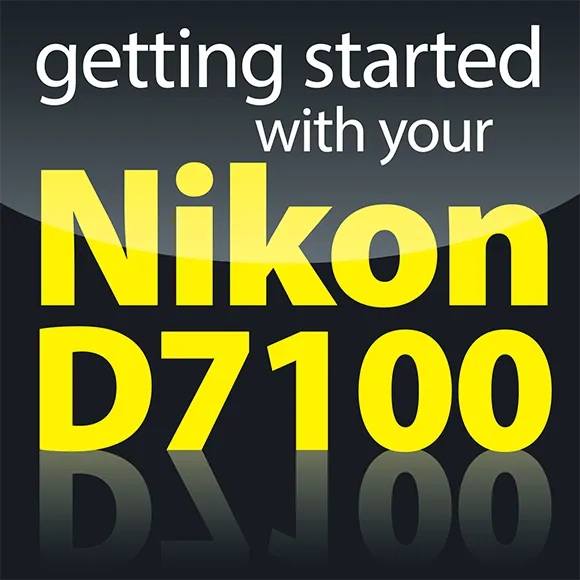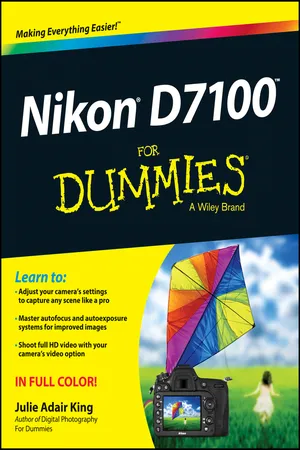Part I
Fast Track to Super Snaps
Visit
www.dummies.com for more great
For Dummies content online.
In this part . . .
Get familiar with the basics of using your camera, from attaching lenses to using the Information display and Control panel.
Find out how to select the shutter-release mode, exposure mode, picture resolution, file type (JPEG or Raw), and image area.
Discover tips for getting good results in the automatic exposure modes.
Start taking creative control by stepping up to Scene modes.
Switch to Live View mode to compose pictures by using the monitor.
Record, play, and trim digital movies.
1
Getting the Lay of the Land
In This Chapter
Attaching and using an SLR lens
Adjusting the viewfinder to your eyesight
Figuring out the displays
Working with memory cards
Getting acquainted with your camera
Customizing basic operations
If you’re like me, shooting for the first time with a camera as sophisticated as the Nikon D7100 produces a blend of excitement and anxiety. On one hand, you can’t wait to start using your new equipment, but on the other, you’re a little intimidated by all its buttons, dials, and menu options.
Well, fear not: This chapter provides the information you need to start getting comfortable with your D7100. Along with an introduction to the camera’s external controls, I offer details about working with lenses and memory cards, viewing and adjusting camera settings, and choosing basic camera setup options.
Looking at Lenses
One of the biggest differences between a digital point-and-shoot camera and a dSLR (digital single-lens reflex) camera is the lens. With a dSLR, you can change lenses to suit different photographic needs, going from an extreme close-up lens to a super-long telephoto, for example. In addition, a dSLR lens has a focusing ring that gives you the option of focusing manually instead of relying on the camera’s autofocus mechanism.
I don’t have room in this book to go into detail about the science of lenses, nor do I think that an in-depth knowledge of the subject is terribly important to your photographic success. But the next few sections offer advice that may help when you’re shopping for lenses, figuring out whether the lenses you inherited from Uncle Ted or found on eBay will work with your D7100, and taking the steps involved in actually mounting and using a lens.
Choosing a lens
To decide which lens is the best partner for your camera, start by considering these factors:
Lens compatibility: You can mount a wide range of lenses on your D7100, but some lenses aren’t fully compatible with all camera features. For example, with some lenses, you can’t take advantage of autofocusing and must focus manually.
Your camera manual lists all the lens types that can be mounted on the camera and explains what features are supported with each type. For maximum compatibility, look for these types: Type D or G AF Nikkor, AF-S Nikkor, or AF-I Nikkor. (The latter is an older, expensive professional lens that is no longer sold but might be available on the resale market.)
All the aforementioned lens types (as well as some others) offer CPU (central processing unit) technology, which allows the lens to talk to the camera. This feature is critical to getting maximum performance from the autofocusing system, exposure metering system, and so on. That’s not to say that you can’t use a non-CPU lens; you just lose access to some camera features.
Information in this book assumes that you’re using a CPU lens that supports all the camera’s functions. If your lens doesn’t meet that criteria, check the camera manual for specifics on what features are unavailable or need to be implemented differently.
Focal length and the crop factor: The focal length of a lens, stated in millimeters, determines the angle of view that the camera can capture and the spatial relationship of objects in the frame. Focal length also affects
depth of field, or the distance over which focus appears acceptably sharp.
You can loosely categorize lenses by focal length as follows:
• Wide-angle: Lenses with short focal lengths — generally, anything under 35mm — are known as wide-angle lenses. A wide-angle lens has the visual effect of pushing the subject away from you and making it appear smaller. As a result, you can fit more of the scene into the frame without moving back. Additionally, a wide-angle lens has a large depth of field, which means that both the subject and background objects appear sharp. These characteristics make wide-angle lenses ideal for landscape photography.
• Telephoto: Lenses with focal lengths longer than about 70mm are telephoto lenses. These lenses create the illusion of bringing the subject closer to you, increase the subject’s size in the f...
























